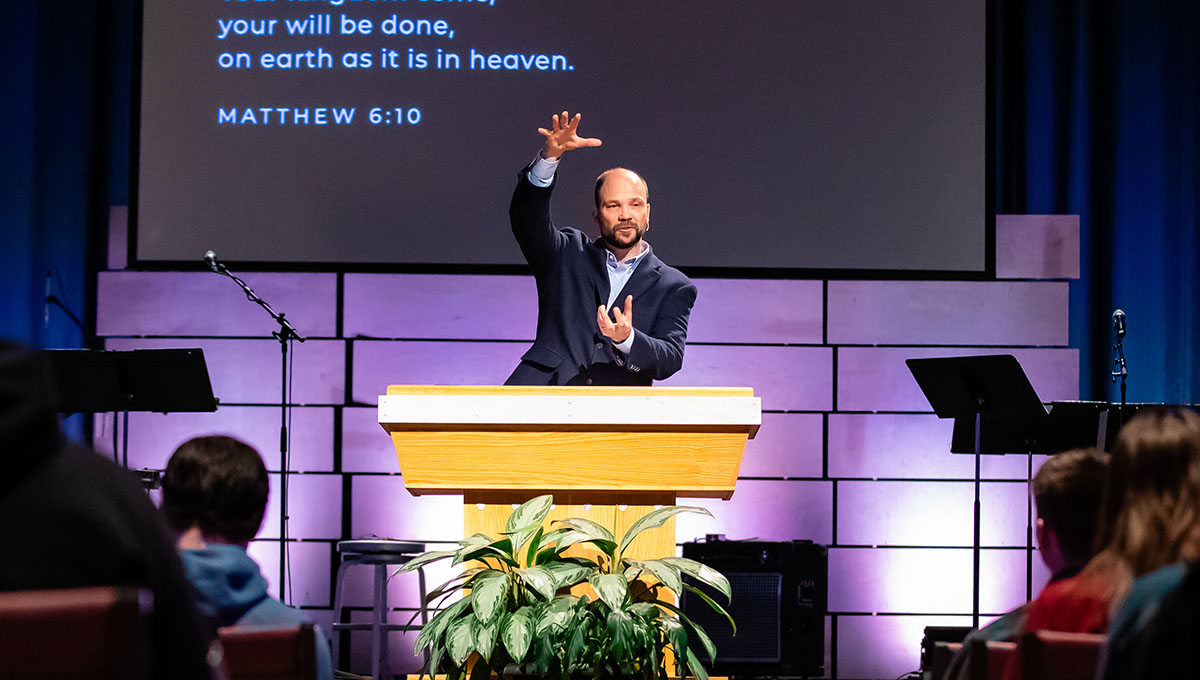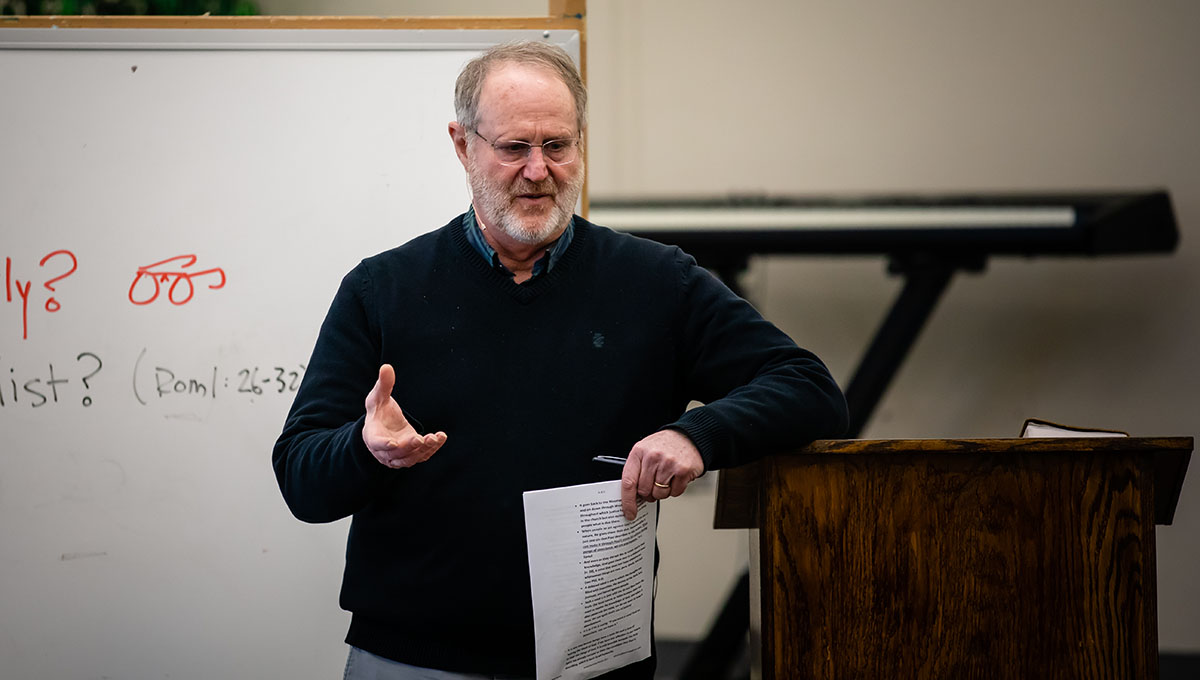How NOT to Read the Old Testament
- Nathan Schneider

I know today’s topic comes as quite a shock, considering how tightly I wrapped up last week and didn’t give any kind of hint that more on the Old Testament might come. But, here we are. Call me an Old Testament (from here on “OT”) advocate, an ambassador for the three-quarters of the Bible we tend to skip over when we open up the Holy Scriptures.
The reality is, even if we’re thoroughly convinced that the OT needs to be a priority, and that we’ve neglected it for far too long, there’s probably this nagging anxiety over trying to read it, study it, and understand it. It’s kind of like that room in your house that you put everything into that you don’t want out when company comes over, and after a while of using this room as the house’s “storage room,” it begins to accumulate junk to a point where you’re not entirely sure how it got this far out of hand, and now the mere thought of actually dealing with all of this leaves you curled up on the floor in a fetal position… No? That hasn’t happened to anyone else? Just me, I guess.
Well, the point of all this is that the OT can be intimidating. It’s big. It spans a considerable length of ancient history (from creation to the close of the OT canon around 400 B.C.). It was written over a period of a thousand years. It’s in a different language, reflects different cultures, and speaks of events which happened far back in the annuls of history. We all know that the only way to eat an elephant is one bite at a time, but those are big bites, and that’s a REALLY big elephant.
So how do you go from OT novice to OT student? I’m not saying you have to be an expert. There are actually very few of those, relatively speaking. But you can’t use that as an excuse to say, “Well, I guess I shouldn’t even try.” Instead, accept the challenge and make a game plan. And that’s where I come in. I’m like your OT tour guide, or your OT financial planner, helping you create a strategy that’s doable.
But before we talk about the RIGHT method to studying the OT, we need to talk about the WRONG methods. Just like going out into the unexplored backcountry, there are things you want to do and thing you don’t want to do to ensure you have a safe and fun adventure in the wilderness. Well, studying the OT is the same way, and once you begin to read the OT and read what others say about the OT, you’ll quickly discover that there are some traps and temptations out there that seem like a good way to go, but actually don’t lead to clarity.
So, with that all said, here are three common methods of studying the OT that you should know about and avoid as you gear up for your backcountry OT adventure.
METHOD #1: Looking for Christ behind every rock and every tree
Now, I can already hear you object to this. “I thought the OT was about Christ!”, you say. Well, it is! And Jesus even said it was. In fact, after his resurrection, when encountered two of his disciples walking along the road to Emmaeus and completely in the dark as to who he was and why the Messiah had to suffer and die, Jesus replied to them, “‘O foolish men and slow of heart to believe all that the prophets have spoken! Was it not necessary for the Christ to suffer these things and to enter into His glory?’ Then beginning with Moses and with all the prophets, He explained to them the things concerning Himself in all the Scriptures” (Luke 24:26–27).
There’s no doubting that the OT spoke of and anticipated Jesus Christ in his coming, his ministry, his suffering, and his rising from the dead. Paul echoes this when he wrote, “But now apart from the law the righteousness of God has been manifested, being witnesses by the Law and the Prophets, even the righteousness of God through faith in Jesus Christ for all those who believe” (Rom. 3:21–22). If you fail to see Jesus in the pages of the OT, you’ve missed the point of the OT! Robert Bergen wrote,
“The church can understand the significance of Jesus’ life only when it understands the legal system established in the Torah. New Testament presentations of Jesus as the ‘Lamb of God, who takes away the sin of the world’ (John 1:29, NIV) and Christ’s body as the curtain though which people must pass to enter the Most Holy Place (Heb. 10:19–20) indicate that the church is expected to interpret at least certain details of the Mosaic cultic law as “a shadow of the good things that are coming” in Christ (Heb. 10:1, NIV). The New Testament leaves no doubt that aspects of Israelite worship were divinely intended to be representative of realities found uniquely in the person of Christ” (Robert D. Bergen, “Preaching Old Testament Law,” in Reclaiming the Prophetic Mantle: Preaching the Old Testament Faithfully, ed. by George L. Klein [Nashville, TN: Broadman Press, 1992], 63).
So if all of that is true, then what’s the problem? Well, simply this: It’s one thing to say that the OT speaks of Christ. It’s another thing to say that everything in the OT speaks of Christ. In other words, when we read the OT, we want to draw Jesus out from the OT text. What we don’t want to do is read him into the OT text where the Holy Spirit never intended him to be found.
Remember, in the end, studying the Bible is about coming to the meaning of the text, and the meaning of any text is determined not by the reader but by the author. The key phrase for Bible study is this: authorial intent.
This kind of sentiment is summed up well by a statement made by Michael Horton, a well-known systematic theologian: “Once we truly grasp the message of the New Testament, it is impossible to read the Old Testament again without seeing Christ on every page, in every story, foreshadowing or anticipated in every event and narrative.” That’s the Christ-centered method of studying the OT, and while it sound spiritual and “Christian,” it ultimately fails to ask the most fundamental of interpretive questions: did God intend for us to find Christ in every story and every event?
Now, we can of course trace the redemptive arc throughout the OT. When we see sin demonstrated in an OT narrative, it points us to Christ as the redeemer of our sin. But that’s more of a secondary level of Christ-centered interpretation. What we’re talking about here is seeing Christ in all the details. It’s one thing to say that the tabernacle in the wilderness anticipated the work of Christ. It’s a completely different thing to say that “fine twisted linen” of the tabernacle curtain (cf. Exod. 26:1) prefigured Christ’s spotless life, the blue signified his heavenly character, the purple his royalty, and the scarlet his suffering. Do we really think that these connections are divinely intended, or are these examples of anachronism…reading something back into the text with the privilege of theological hindsight?
So, in summary, this first method to avoid is a fallacy that says the only legitimate meaning in the OT is a meaning tied directly Jesus…not indirectly, not secondarily, not through the great redemptive arc, but directly.
And that leads us to a second method to avoid:
Method #2: Looking for Types off the beaten track
When we talk about “types” in the Bible, we’re simply talking about a divinely-established pattern. In the OT, a person or event is established a “type” or pattern that anticipates something bigger and more significant in the NT. That NT reality is known as the “antitype”…it’s what the type points to.
Now, just like in the previous point, we have to be clear and recognize that the Bible contains types. To say that it doesn’t would be to deny some very clear indications in Scripture. In Romans 5:14, for instance, Paul speaks of Adam and identifies him as a type of Jesus: “Nevertheless, death reigned from Adam until Moses, even over those who had not sinned in the likeness of the offense of Adam, who is a type of Him who was to come.” In other words, Adam’s role as head and representative of the human race foreshadowed or “typified” the role of Christ as the head a new humanity made up of all those who believe. In this way, Adam is a type…a pattern…of Christ. Adam represented everyone in him when he sinned (all humanity) just like Christ represented everyone in Him when he died and was raised (all believers).
There are numerous types established in Scripture. They can involve people like we’ve just discussed (e.g., Adam, Melchizedek), but they can also involve events (e.g., the flood, brazen serpent), institutions (e.g., OT feasts), objects (e.g., altar of burnt offering, incense), and even offices (e.g., prophet, priest, king). The key to each of these types, however, is that the NT gives explicit witness to the divinely-intended type established in the OT and the corresponding antitype revealed in the NT.
It’s at this juncture that we can become tempted to wander off the established trail and cut our own path. When we move from established types to an entire approach of typology that we start to venture off on our own. Typology is a method of reading the Bible, where you’re intentionally trying to make type-antitype connections with everything. Similar to the Christ-centered method we saw previously, the type-centered approach seems at first blush to be a spiritually-promising method, offering lots of deep, hidden truths and connections between OT people end events and NT theological realities.
But once again, we have to return to the fundamental principle of all Bible study, which is that the meaning of the Scripture is whatever the author intended, not what the reader wants it to mean or thinks it should mean. In the end, when we use “types” as a lens for interpreting the OT, all we’re really doing is engaging in allegory, where we’re stripping away the OT text of its basic meaning and searching for some deeper, hidden meaning in the text. That’s a problem, first because we’re under the false impression that the normal, natural meaning of the text isn’t enough, and second, that there’s no objective verification to tell us whether the “type” we see in a given text is actually a type or just a figment of our type-seeking imagination. Walter Kaiser said it well when he wrote,
Another practice in medieval and early reformation times was to assume that many, if not most, things in the Old Testament were types of something else in the New Testament. Now there are real types in the Bible, but all true biblical types have clear divine designations shown in the same contexts with the alleged type from the Old Testament. Consequently, a person, an institution, an act, or an event that can claim by divine designation in the Old Testament that it is a partial picture of a greater reality to come can be recognized by all true interpreters as a type. But the problem arises when everything in detail, such as all that is in the tabernacle, is made a type of something else. Surely, as one of my professors wisely remarked one day in class, some of the ropes and pegs in the tabernacle were meant to hold it up and to help it stand up erect! The problem with typology is that many take it far beyond what we have biblical authorization to do (Walter C. Kaiser Jr., Preaching and Teaching from the Old Testament: A Guide for the Church [Grand Rapids: Baker Academic, 2003], 43–44).
Kaiser really nails it here. Sometimes, a rope and a peg is just a rope and a peg. It doesn’t all have to foreshadow some greater spiritual truth. And what’s more, what guard rails exist outside the interpreter to ensure his particular type is accurate? In reality, if you were to collect ten allegorizing preachers of students and ask them to independently interpret the same OT text, they would likely find ten different types in it! How do we determine which interpretation is correct when there’s no objective means of determining the type in the first place?
To summarize, while types certainly exist in the Bible, when we study the OT we want to limit our identification of types to those the Scripture specifically identifies while avoiding typology which looks for types and hidden meaning beyond those identified in the Bible.
Method #3: Looking for examples
Perhaps the most common trap we can fall into when we try to read and study the OT is the “good example” method. There’s another name for it: it’s called “moralism.” Moralism simply means reading the OT and trying to find the moral lesson to follow. It sees the OT as a series of examples of how to live.
Now, just like I’ve done with the previous two methods, let me make something perfectly clear: there are good examples to follow and bad examples to avoid throughout the OT. That should be pretty obvious to us. And just to reinforce this point, it was the apostle Paul who told the Corinthians concerning the OT, “Now these things happened to them as an example, and they were written for our instruction” (1 Cor. 10:11). Of course, we need to recognize the events in the OT for the examples they give! Of course, we’re to learn from those examples as they instruct us as to what to do and what not to do!
But…and that’s a significant “but”…we can’t act as though these moral examples are the divinely-intended point of the OT. We can’t read the OT convinced that the sole purpose of the OT (especially OT narrative) is to give us moral examples to follow. And certainly we can’t extract stories from their contexts and treat them like moral lessons on how to be better people. Yes, Joseph provides an example of an OT individual to emulate. He flees from immorality when enticed by Potiphar’s wife, works hard for the jailer and later for Pharaoh, and forgives his brothers who had mistreated him. But is that what the Joseph narrative is really all about? Be like Joseph! Work hard! Flee immorality! Forgive your enemies!
When we focus specifically on Joseph’s actions, we inevitably lose sight of the larger unfolding events in the narrative. In reality, the point of Joseph fleeing isn’t about fleeing. He was thrown in prison anyway, so perhaps the lesson is, “Don’t bother doing what’s right because you’ll get punished anyway!” That’s a little tongue-in-cheek, but the point is the same. The purpose of the narrative is that God was behind all the events that happened to Joseph. God wanted him in prison so that he could give him the opportunity to interpret Pharaoh’s dream so that he could rise to the rank of second in the kingdom of Egypt so that he could provide a place where God could bring Jacob and his sons to protect then and grow them into a nation and then rescue them from bondage and establish his covenant with them. The most important statement in the Joseph narrative (Gen. 37–50) is not about anything Joseph did but rather what he said: “Do not fear, for am I in the place of God? As for you, you meant evil against me, but God meant it for good, to bring it about that many people should be kept alive, as they are today” (Gen. 50:19–20). The Joseph narrative is a grand tapestry of how God sovereignly works through providence, even using the sinful actions of others to accomplish his plans and fulfill his promises (cf. Gen 15:13 where God promises Abraham that his descendants will spend 400 in affliction in a foreign nation before he frees them and punishes the nation who enslaved them).
Moralizing the OT, while tempting and immediately practical, is fraught with challenges on the simple fact that not every person in the OT is meant to be followed. Samson, while given superhuman strength, is presented as a moral failure. He’s the kind of hero Israel inevitably deserved because he reflected their immorality. Esther, while boldly and daringly standing up for her people, is a less-than-ideal model for any young girl to follow. She rose to position as queen by means of a beauty pageant in which she spent a night with the king. The book of Esther is not given to us simply to provide moral examples of bravery in the face of danger. It’s given to us to remind us that even when God’s people have forgotten him, he is still working in the background, protecting and providing for them because he has covenanted his love to them and will not forsake them forever. The story of Esther is one long story of God’s providence, guiding the events of history along in a series of interesting “coincidences.”
David Deuel wrote in reference to moralizing preaching,
Sermons that focus primarily on the behavior or character of an individual in the narrative…may miss the passage’s broader theological teaching. Some narratives do prescribe behavior, but the Joseph story does not merely present a model of how young people should be or behave. If the preacher is looking for an exemplar and settles on the Joseph story, he has exchanged the story’s unifying structure for his own conceptual structure. He chooses the narrative only for the sake of certain details within the story. Joseph’s behavior may well be part of the message, but the preacher has made it the whole message” (David C. Deuel, “Expository Preaching from Old Testament Narrative,” in Preaching: How to Preach Biblically, by John MacArthur, et al. [Nashville, TN: Thomas Nelson, 2005], 231).
So how do we summarize all of this? Well, let me put it to you this way.
- If you don’t see Christ in the OT, check your glasses! But, if you see Christ everywhere in the OT, also check your glasses.
- The OT does foreshadow spiritual realities that become clear in the NT. But, don’t get swept up in the looking for “hidden” or “secret” meaning in the text. If the text says it points to something greater, then obviously it does!
- Be careful about moralizing OT narratives. Most of the time, biblical narratives are given to tell us what happened (descriptive), not how things should happen (prescriptive). When a narrative is prescriptive, the text will make it clear.
These are the three methods to avoid when you’re trying to read and understand the OT. But how SHOULD we do it then? Im glad you asked. That may just be what we talk about next week…










